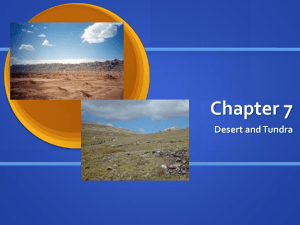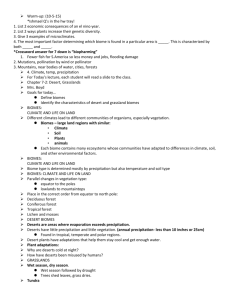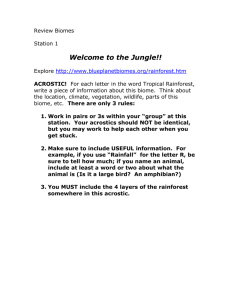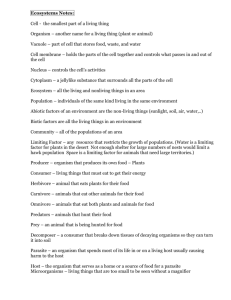Ecology Desert, Tundra, and Grassland student notes 2015
advertisement
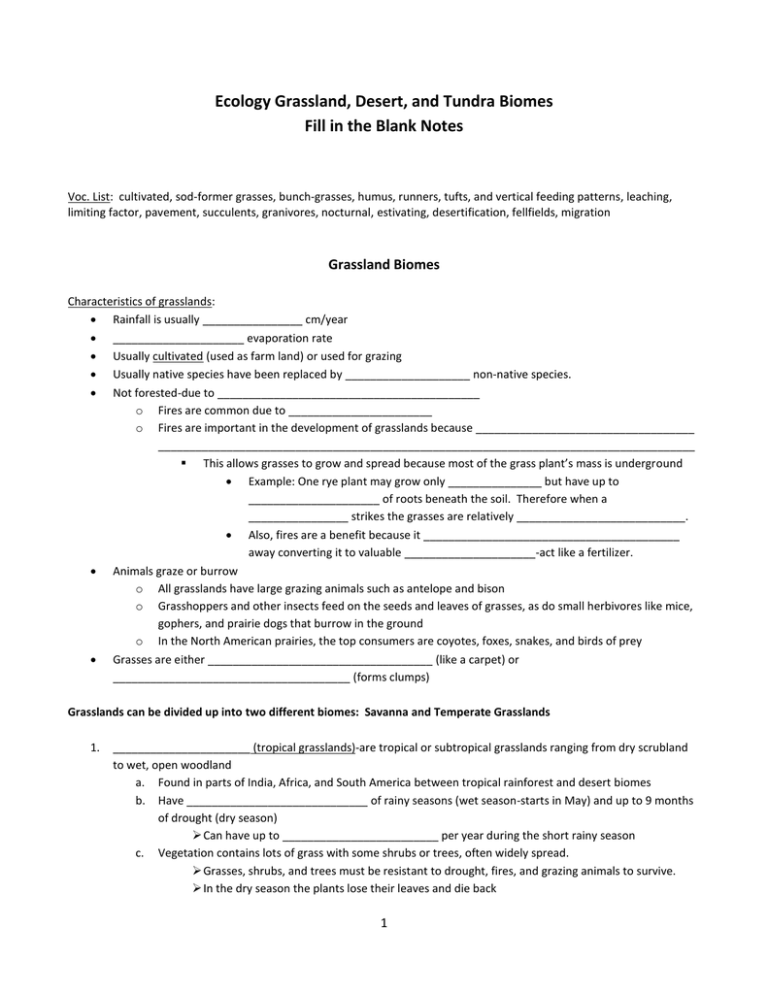
Ecology Grassland, Desert, and Tundra Biomes Fill in the Blank Notes Voc. List: cultivated, sod-former grasses, bunch-grasses, humus, runners, tufts, and vertical feeding patterns, leaching, limiting factor, pavement, succulents, granivores, nocturnal, estivating, desertification, fellfields, migration Grassland Biomes Characteristics of grasslands: Rainfall is usually ________________ cm/year _____________________ evaporation rate Usually cultivated (used as farm land) or used for grazing Usually native species have been replaced by ____________________ non-native species. Not forested-due to __________________________________________ o Fires are common due to _______________________ o Fires are important in the development of grasslands because ___________________________________ ______________________________________________________________________________________ This allows grasses to grow and spread because most of the grass plant’s mass is underground Example: One rye plant may grow only _______________ but have up to _____________________ of roots beneath the soil. Therefore when a ________________ strikes the grasses are relatively ___________________________. Also, fires are a benefit because it _________________________________________ away converting it to valuable _____________________-act like a fertilizer. Animals graze or burrow o All grasslands have large grazing animals such as antelope and bison o Grasshoppers and other insects feed on the seeds and leaves of grasses, as do small herbivores like mice, gophers, and prairie dogs that burrow in the ground o In the North American prairies, the top consumers are coyotes, foxes, snakes, and birds of prey Grasses are either ____________________________________ (like a carpet) or ______________________________________ (forms clumps) Grasslands can be divided up into two different biomes: Savanna and Temperate Grasslands 1. ______________________ (tropical grasslands)-are tropical or subtropical grasslands ranging from dry scrubland to wet, open woodland a. Found in parts of India, Africa, and South America between tropical rainforest and desert biomes b. Have _____________________________ of rainy seasons (wet season-starts in May) and up to 9 months of drought (dry season) Can have up to _________________________ per year during the short rainy season c. Vegetation contains lots of grass with some shrubs or trees, often widely spread. Grasses, shrubs, and trees must be resistant to drought, fires, and grazing animals to survive. In the dry season the plants lose their leaves and die back 1 d. e. f. The plant have large horizontal root systems to obtain water even far away ____________________ are long horizontal stems above the ground. Runners are used by some plants to reproduce quickly The coarse grasses have vertical leaves to conserve water and allow less of the plant to be exposed to the hot sun. Grasses grow in _______________________-large clumps of tall, coarse grasses. Animals have ____________________________________________-animals eat vegetation at different heights allowing for different eating habits. The trees and shrubs have thorns or sharp leaves that keep them from being eaten by grazing animals, such as gazelles. They also grow and recover quickly when damaged. Grazing Animal Examples: gazelles, elephants, zebras, giraffes, and black rhino Grazing animals are herbivores Most migrate to search for ______________________________________________________ Some predators follow ____________________________________________________________ Most savanna animals only give birth during the ________________________________________ Other organisms: Termites are small but build the _________________ homes that can be seen across the whole savanna ________________________________ build round next from the droppings of other animals and then lay their eggs in them Ostriches are _______________________ birds with great eye sight and run fast when a predator is after it. They also lay huge eggs that are big enough for several people to enjoy. 2. Temperate grasslands: a. Moderate rainfall to support mainly grasses b. Cover large areas of the interior of most continents c. Trees and shrubs can’t be established because of frequent fires and not enough rainfall. d. Soil is _______________________ and ___________________________________________________ Decomposition ___________________ down during the winter months Four main types: Prairie, Steppe, Veldt, and Pampas _______________________-are grasslands characterized by rolling hills, plains, and sod-former grasses. Found in the United States-Great Plains (North America’s _________________________________________)-1.4 million square miles As you move from the east to west the rainfall decreases Most rain near mountainous areas up north Soil in prairies can hold water very well because soil organisms create ___________________________ that hold the water. _______________ helps hold moisture too-layer of organic material formed as plants and animals decompose. Lots of flowering plants and herbs Most of the grasses have roots that form a mat in the soil-_________________________________________________ Big bluestem grass have roots 7 ft. long 2 Switchgrass have roots 11 ft. long Animals: buffalo, elk, deer, rabbits, and prairie dogs Prairie dogs dig huge underground tunnel systems Problems: Lots of farming Lots of endangered species ____________________________ –are dry and cold grasslands Found in every continent except Antarctica and Australia often near desert areas-mainly in the USA, Mongolia, Siberia, Tibet and China Most people won’t live in these areas because of the extremely hot and dry summers and very cold winters i. Common wildfires in the summertime ___________________________ are short, fine bladed grasses that form in clumps The more rain the taller the grass Some animals ______________________ in the colder areas to save energy Rainfall: 10-30 inches of rain /year Problems: Lots of endangered animals Human farming and digging for oil __________________________ Found in South Africa beside the savanna and have similar organisms The 1st ___________________________ lived in these areas Usually the animals travel in large _____________________________ Zebras, gazelles, and wildebeests often travel together for more protections from predators like lions Have more trees and shrubs than the savanna A thirsty elephant will tear a baobab tree apart to eat the spongy, moist inner wood Dominate grass are the _____________________ grasses Rainfall: 15-35 inches of rain/year Temperature average: Summer 65-80oF Winter 45-60oF Problems: Lots of farming Ostrich extinct in these areas (_______________________________________________) ________________________ Found in South America (mainly Argentina-south of Buenos Aires to Uruguay)-300,000 square miles-South America’s _____________________________________________) Flat ground that is _____________________________________________ Fertile plains with mainly grasses similar to the prairies of North America Other plants include cattails, water lilies, and reeds They have adapted to these areas 3 A lot of organisms ___________________________________ in the ground including owls Bird examples: Have different types of finches (birds) and Greater Rhea (cousin to the Emu) Dry season is the summer Temperature average: 18oC __________________________________ Temperate woodland that receives enough rain or mist from the ___________________________________ to support trees and shrubs found worldwide. o Found in Middle latitudes about 30o North and South of the _____________________________________ o The areas have moderately dry, coastal climates with very little or no rain during the summer o Land can be flat plains, rocky hills, and mountain slopes-often seen in Old Western movies Plants: Bay laurel, herbs, olive trees, scrub oak, blue oak, coyote brush, common sagebrush, flowers such as Fairy Duster (pink), French Broom (yellow), and King Sugar Bush (pink flower that is about one foot across with paddlelike leaves o Leaves are _______________________________________ to help retain water o Leaves contain _________________ to promote burning of other plants that compete with chaparral plants-chaparral plants adapt well to fires and can resprout new roots __________________ Animals: Quails, alligator lizards, chipmunks, mule deer, coyotes, jack rabbits, horned toads, praying mantis, honey bees, and ladybugs o Animals often use _____________________________________________ Average Temperatures: 10oC in the winter and 40oC in the dry summer o Fires are ___________________ in the summer months Problem: Threatened by human development Deserts ______________________ of desert soils has enabled some nations to turn deserts into croplands. In the Middle East, for example, irrigation projects have turned the Golan Heights into citrus orchards. Such projects require careful planning and management to avoid draining water resources and accumulating salts in the soil. Common properties of a desert The _______________________________________ is high and exceeds rainfall-so very little rainfall o Rarely 25 cm of precipitation/ year Some areas 0-1 inch/ year o Lack of rainfall is a _______________________________________ (an abiotic or biotic factor that restricts organisms in some way) for desert biomes ________________________________________________________________________ Formation of the Desert Deserts cover roughly ___________ of the Earth’s surface and are found on every continent except ____________________ Most Hot deserts are found between ____________oN (Tropic of Cancer) or S (Tropic of Capricorn) The location of the desert varies slightly from day to day because wind carries the sand and the land formations trap the sand 4 Erosion in the desert: __________________________________________________ o Desert soils tend to be rich in minerals but poor in organic material because of erosion Rainwater moving through soil carries minerals deeper into the soil by a process known as _________________________________________(water causes minerals to go out of the rocks, soil, and possibly organism and go elsewhere) Very little rain forms in deserts so very little leaching occurs in the soil. As a result, the upper layers of the desert soil become rich in minerals Wind erosion occurs where loose dry desert soil and expose a lower layer of soil called ____________________________________-the desert floor (made of hard-baked sand, bare rock particles, or both) Problem/Limiting Factor: People also cause deserts to form by _______________________________________________ o In this case, people over-farm and allow animals to graze too much losing the nutrients, grass/crops. Lack of water 1. Four Types of Deserts Hot and Dry Deserts Plants: Woody-stemmed and soft brittle-stemmed shrub plants and a wide variety of other plants including cactus o _________________ have spines that are actually considered leaves The spines reduce the loss of water by reducing the surface area from which water can evaporate The spines also protect cacti from being eaten Cactus also store liquid in their tissues Plants such as cacti, are called _____________________________________ because they have thick, water-filled tissues The stored water allows plants in dry areas to survive Animals: o Primary producers depend upon the availability of water o __________________________________________________ are important herbivores of the desert ecosystem-for _________________________________ Birds, insects, beetles, and _________________________ mammals Ex. Ants gather seeds underground o Most desert animals adapt to the heat ______________________________________________-burying themselves in the ground and sleeping through the dry season Elf owls nest in _________________________ to avoid predators Insects and spiders are covered in ________________________________ to protect themselves and help them _________________________________________ Reptiles like Gila monster and rattlesnakes, have a ____________________________________ to prevent water loss Rodents like kangaroo rats store their water in the form of ___________________________ Most rodents and reptiles burrow in the ground during the daylight and seek food at night-_______________________________ Average Temperature: o 20-25° C can get cool at night daytime temperatures can reach _______________ in extreme conditions 5 lowest winter temperatures can be -18oC Precipitation: o _______________________________________ of rainfall/year 2. Semiarid Deserts –________________________________ with similar plants and animals as Hot and Dry Deserts Average Rainfall: ____________________________ Temperatures range from _________________________________ 3. Coastal Deserts-Found in coastal areas Plants: black sage, small flowers, and different species of brush and bush Animals: Several have specialized adaptations o Amphibians have an ____________________________ life cycle to improve their odds of maturity before the dry season Some mature toads seal themselves in burrows with _____________________________________ 8-9 months or when heavy rains occur o Some insects and shrimp lay eggs that stay ____________________________ until heavy rains o Coyotes, badgers, eagles, owls, lizards, and snakes Average Rainfall: 8-13 cm/year Average Temperature: o -2 to 14°C winter o 21-25°C summer 4. Cool Deserts These areas can have _______________________________________ o Antarctic and Greenland Animals: o Jack rabbits, kangaroo rats, mice, squirrels, lizards, badgers, and coyotes o Most _____________________________________ burrow underground Plants: o Sagebrush is the dominate groundcover o Most deciduous plants have ___________________________ leaves Precipitation: Rain or Snow (in the winter): 9-46 cm/year Average Temperature: o Summer: 21-26oC o Winter: 2-14oC Tundra General Characteristics of Tundra Biomes Cold and desert-like Some areas have glaciers ____________________________-Rock desert _______________________________ the tundra landscape _______________________________: permanent frozen layer of soil o All vegetation have to grow close to the _________________________________________ Water can’t ______________________, so flatlands of the Arctic are wet and covered with shallow lakes and bogs 6 Fine soil material and clay Problems: o Nutrients are low due to short growing season: Nitrogen is unavailable for N cycle Tundra Animals Many of the animals in the Tundra migrate. __________________________________________-Large groups of animals that travel together for water and food. o Ex. Caribou (close relative of the reindeer) is a large migratory mammal Two Types of Tundra I. Arctic Tundra- Grassland and mixed shrub-land in the Arctic Location: Latitudes ________________________________ (Arctic Pole) o Some areas receive 24 hours of Sunlight in the summer and 24 hours of darkness in the winter Permafrost is 10 inches to 3 feet deep Growing season ___________________________________ so plants such as moss, shrubs, grasses, and small colorful wildflowers are possible Plants: o Two most common plants are bearberries and willows Bearberries are only found in Tundra biomes and the berries are often eaten by birds Willows are often eaten by humans because they are rich in Vitamin A, C, and Calcium and used by humans to start fires o Trees get rough _____________________________ tall and appear more like a scrub than a tree The short growing season, limited space for roots to grow, and strong winds cause dwarfed trees Animals: reindeer, caribou, lemmings, voles, arctic hares and foxes, wolves, squirrels, lots of bird, black bears, grizzly bears, and polar bears Insects: mosquitoes, flies, moths, grasshoppers, and arctic bumble bees Fish: salmon, halibut, and trout Temperature range: -70oF in the winter to 80oF in the summer Average Precipitation: rain or snow (mainly) 6-10 inches Problems: o Global warming –melting of permafrost o Short growing season o Extreme cold o Lack of water Alaskan Pipeline: Took several years of planning, construction began on the Alaska oil pipeline, which transports oil 1285 km south from the North Slope of Alaska. o The pipeline was completed three years later. o The first oil left Prudhoe Bay (North Slope) on June 20, 1977 Because oil must be kept warm in order to flow, parts of the pipeline were constructed above the ground to protect the permafrost from melting. 7 II. To avoid interfering with migration of caribou and other animals, the pipeline includes 400 raised sections for animal crossings. Alpine Tundra-Mountainous areas at high latitudes where trees can’t grow Able to withstand wind due to low and ground-hugging vegetation Growing season is _________________________________ Animals and plants are about the same as Arctic Tundra Evening temperatures are ______________________________________________________________ Precipitation same as Arctic Tundra 8


